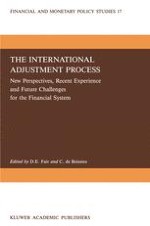1989 | OriginalPaper | Buchkapitel
External adjustment in small open economies — some recent experience
verfasst von : Johnny Åkerholm
Erschienen in: The International Adjustment Process
Verlag: Springer Netherlands
Enthalten in: Professional Book Archive
Aktivieren Sie unsere intelligente Suche, um passende Fachinhalte oder Patente zu finden.
Wählen Sie Textabschnitte aus um mit Künstlicher Intelligenz passenden Patente zu finden. powered by
Markieren Sie Textabschnitte, um KI-gestützt weitere passende Inhalte zu finden. powered by
The innovations in financial markets during the last few years have had a major impact on the economic policy environment in all countries. The innovations have constituted an international phenomenon; though most of them have been first introduced in the largest markets, they have quickly spread to the small countries. As a result, regulations of various kinds have become less and less effective, financial markets have developed quickly, and integration across borders has advanced at a rapid pace. This has imposed new limitations on national monetary policy. Many of the bigger countries have allowed their exchange rates to float in order to maintain the effectiveness of monetary policy.1 However, in most of the small industrial economies the exchange rate has been fixed within the framework of monetary co-operation (EMS) or by pegging to single currencies or currency baskets. Hence, the external constraints on monetary policy have become increasingly apparent in these countries as monetary integration has proceeded. There is no doubt that this has also affected the division of labour between different policy instruments. But do these countries have any longer enough instruments to simultaneously maintain external and internal balance?
